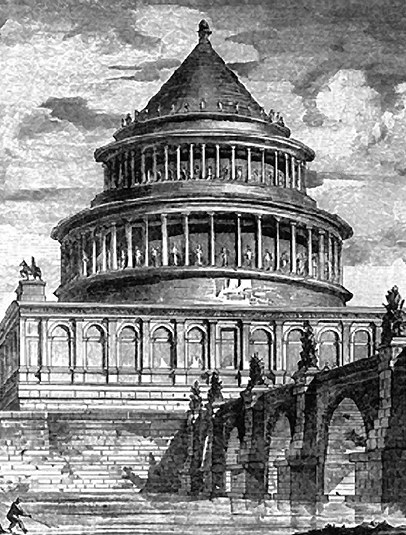Mausoleums
BACKGROUND
Function
A mausoleum (pl. mausolea/mausoleums) is a structure that contains the remains of the deceased and commemorates his importance through impressive size and richness.
Cenotaphs
Another form of commemorative structure, the cenotaph, differs from a mausoleum because it does not contain the remains of the person to whom it is dedicated.
Origin of Term
The term mausoleum is derived from the name of King Mausolos of Caria (Asia Minor), who died around 350 BC. His tomb at Halicarnassus was so large and magnificent that it was included among the "Seven Wonders" of the ancient world. Much of the stone used in its construction was removed in the late fifteenth and early sixteenth centuries for use on a castle nearby.
Roman Burial Practices
Roman burial practices included placing the whole body in a sarcophagus or cremating it and then placing the ashes in urns. Mausoleums were used to house both forms of receptacle.
Roman law prohibited burial within the city, and cemeteries and tombs were located beyond city walls.
Modifications to Surviving Mausoleums
Many of the surviving mausoleums owe their preservation to having been converted to fortresses in the Middle Ages. Their mounds were removed, their walls were heightened, and crenellations were added around the top.
DESIGN
Precedents
The essential features of a Roman mausoleum, a circular wall covered by a conical mound, had several precedents.
●Mycenaean beehive tombs. In Greece during the second millennium BC, beehive-shaped stone tombs were mounded over with earth.
●Etruscan tumuli. In pre-Roman Italy, the Etruscans covered their tombs, which were beehive-shaped or rectangular, with a conical mound of dirt that was braced at the bottom by a circular retaining wall.
Three-Part Composition
Many mausolea were composed of three basic layers.
1.Square base. A square (or sometimes, a circular) base elevated the main cylinder.
2.Circular wall. A circular wall defined the mausoleum's cylindrical form. A web of walls following concentric and radial courses divided the interior into compartments that served as separate tomb chambers for family members. An infill of earth within the compartments added stability to the interior walls and helped to minimize lateral pressure against the outer walls.
3.Trees and sculpture on top. Earth was mounded on top in a conical form and planted with evergreen trees, often cypress. The mound was usually topped by sculpture such as colossal standing images or quadrigas, chariots pulled by four-horse teams.
INFLUENCE ON LATER ARCHITECTURE
Early Christian
Circular burial architecture was continued into the Early Christian period by martyria and mausoleums like the Tomb of Santa Costanza in Rome and the Tomb of King Theodoric in Ravenna.
Renaissance
The rounded-top, cylinder-on-cube shape characteristic of Roman mausoleums was recreated by numerous sketches and several Renaissance churches. The mortuary connotations of this shape were especially appropriate to churches that were intended to serve as tombs such as Bramante's Santa Maria delle Grazie in Milan, which was planned to house the Sforza tombs, and St. Peter's in Rome, which stands over St. Peter's tomb.
EXAMPLES OF MAUSOLEUMS
Ancient Precedents
♦ Treasury of Atreus, Mycenae, Greece, 13th century BC
♦ Etruscan tumuli, Cerveteri, Italy
Roman Cenotaphs and Mausoleums
♦ Cenotaph of the Julii, Saint-Rémy, France, 40 BC
♦ Mausoleum of Augustus, Rome, 28-23 BC
♦ Tomb of Caecilia Metella, Rome, c. 20 BC
♦ Mausoleum of Hadrian, Rome, AD 135-39



 Add Placemark
Add Placemark Go Back
Go Back 





